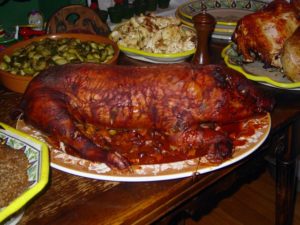One of my proudest moments as a cook was taking a picture-perfect roast suckling pig out of the oven the first time I attempted to make this gorgeous dish as I’d seen it done in the Isthmus of Tehuantepec. My teachers there were Venancia Toledo Hernández and her son Luis Armando, both superb cooks. Venancia has a stand at the market in the town of Ixtepec, and amazing enterprise that sells embroidered blouses, huipiles (sleeveless tunics), and skirts along with fresh cuts of meat butchered in the rough and ready Oaxacan manner and — on Sundays — an assortment of local dishes. One of the best is this succulent roast pig stuffed with a fruit and vegetable mixture. The intense sweet-and-sour seasonings (including Worcestershire sauce and pickled olives) typify the bold Isthmian approach to flavoring.

Since the original dish as Venancia prepared it may not be an option for everyone, I have experimented with some variations. The picadillo (chopped fruit mixture) in her version contained the innards of the pig such as spleen, lungs, and heart, finely chopped and sautéed with the other ingredients. Without these, the stuffing is different but still delicious. I also tried the recipe with and without the fresh orange juice that Venancia adds to the baking pan. It’s good both ways — a matter of rich citrus flavored roasting juices versus the wonderful crisp skin you get by leaving out the liquid.
Venancia and Luis also make this dish with roast loin of pork instead of suckling pig. I have included this version (using boned pork together with the reserved bones) for those who cannot manage a suckling pig. Measure your oven and roasting pan and consult local butchers before deciding which version to use. A 12 to-15 pound suckling pig will probably be 18 to 20 inches long, and you need to figure in at least 2 or 3 more inches to clear the sides of the oven. I do not recommend trying to roast a pig larger than 16 pounds.
Venancia used a deep oval clay pot just large enough to hold the pig — the snugger and deeper the roasting pan, the better. The most time-consuming part of the preparation is dicing the ingredients for the picadillo. It is worth taking the trouble to cut everything into neat 1/4 to 1/3-inch dice that will keep both their shape and texture in cooking.

